Sea Scallops
From Long Island’s Atlantic Coast
Sea scallops are versatile, easy to prepare, and always in season. Let’s demystify this favorite Long Island seafood with everything you need to know about buying, preparing, and cooking them.
First off, let’s debunk the common myth that sea scallops are stamped out of skate wings. They are not. Not here on Long Island anyway.
I’ve heard this myth time and time again, and I just don’t understand it. I suppose you could make imitation scallops by stamping them out with a cookie cutter, but the flavor and texture of skate is so very different it would be hard to fool anyone who has ever tasted a real sea scallop.
So where do sea scallops come from? Well, as the name suggests, these are scallops that live in the ocean. (Unlike bay scallops which live in the bay.) And while not found exclusively on Long Island, are abundant in Atlantic waters off our south shore.
Sea scallops are harvested by boats using large dredges to scoop them up from the sea floor. Smaller boats will fill up their holds by the end of the day then return to port to deliver their catch. Scallops from these boats are sold as “day” or “day boat” scallops.
The video below shows a day boat havesting, shucking, and eating scallops.
Larger vessels can fish for days at a time and will shuck and freeze the scallops as they are caught. Many of these scallops end up in supermarkets and will bear the label, “previously frozen,” and/or “water added.” Avoid these if you can.
Buying Sea Scallops
Sea scallops are readily available in local fish markets, and if you live near the shore and know where the fishing boats unload, you can sometimes buy them directly from the fishermen.
When buying sea scallops keep the following in mind:
- They should be cream/tan in color or sometimes pinkish.
- Their aroma can be fairly strong but never fishy or off in any way.
- They should appear moist, but not oozy, and not dried out.
- The flesh should be tight, not loose or falling apart.
Scallops lose moisture when stored, frozen and defrosted. To reduce this loss scallops are soaked in a solution of sodium tripolyphosphate (STP), a common, safe food additive. However, STP is sometimes used to make the scallops absorb more water than they would naturally hold and increase beyond their original weight. This is illegal, but sometimes it is done anyway.
Look for these signs of excessive chemical treatment:
- Color is white or bleached looking.
- Scallops are sitting in an excess of milky liquid.
- Scallops are unusually large or falling apart.
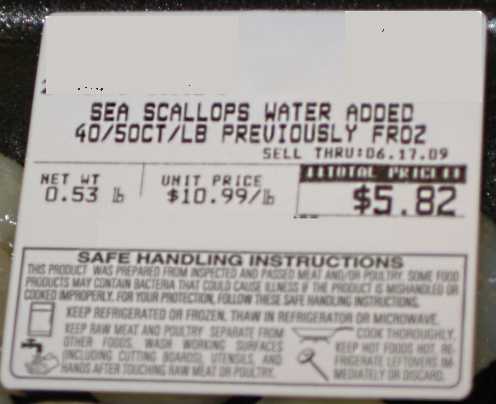
Water added, previously frozen. No thanks!
Sea scallops that have not been treated in this way are sold as dry, chemical free, or day-boat scallops. And please don’t buy those prepackaged scallops in the supermarket. They have most certainly been chemically treated.
Off the Boat
In most areas of the country you have to take what you can get, but on Long Island we are fortunate enough to have easy access to the fishing boats.
Buying right off the boat is the best way to get fresh, unadulterated sea scallops, but can be a little unpredictable until you get to know the captains.
At the dock ask around to find out who’s fishing for scallops and when they typically come in to port. Once you know what boats are scalloping you can talk to the captains to see if they have any extra scallops they can sell or if they are willing to take an order from you.
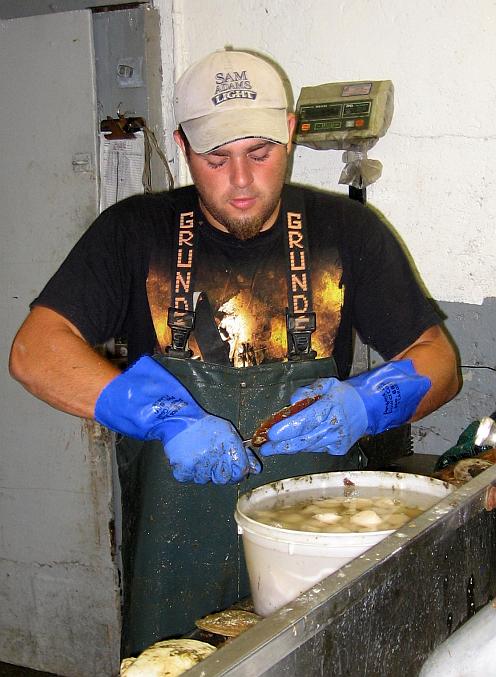 This fisherman
is shucking his day-boat catch at the fish market
This fisherman
is shucking his day-boat catch at the fish market
Buying from the fishermen is a bit different than buying from a market. These are busy men with no time to fool around, so you want to be prepared and to the point.
Bring a heavy paper or canvas bag with you to hold unshucked scallops, and a plastic container to hold scallops if they are already shucked. Buying unshucked scallops is your best bet because then you’ll get to enjoy the roe which is not available once the scallops are shucked.
Politely ask if you can buy some scallops. If you’re asked how many you want, hold up your bag or container, a $20 bill, and say “$20 worth.” Whatever he gives you will be more than that same $20 would have bought in the fish market. Thank the fisherman and be on your way.
Shucking Sea Scallops
Scallops are the easiest of all the shellfish to open. All you need a sharp knife and good light. To make the scallops easier to open I recommend tossing them in the fridge or on ice for a while. The cold makes them open a little and slows them down enough so that you can open them before they have a chance to clamp down on your knife.
Everything you need to know about shucking, cooking, and eating
Place a scallop on the table open side up. Look inside the scallop for the big white muscle that holds its shell closed. With the tip of your knife slice through the muscle as close to where it attaches to the shell as possible.
Once you’re completely through, the shell will almost pop open. Separate the shell halves and remove the innards. Cut the scallop meat free from the other shell and you’re done.
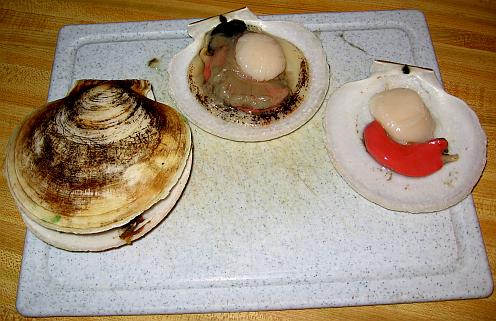
Whole, open with viscera, scallop meat and roe
As you’re shucking your scallops you’ll notice a large red or tan organ curled around the scallop muscle. This is the roe, a delicious part of the scallop that you can’t get unless you buy live scallops and shuck them yourself.
In Europe sea scallops are always served with the roe, but in this country “roe-on” scallops just haven't caught on. It's a terrible waste of food, and from a fisherman's point of view, loss of income. Geoffry Day, a seafood management consultant, has been trying to change that by developing the roe scallop market in New England and Long Island. Learn more here.
In the meantime, save the roe and cook it along with your scallops.
Cooking Sea Scallops
These shellfish have a very delicate flavor that stands well on its own, so there’s no need for fancy sauces or coatings. Pan seared sea scallops are popular here on Long Island and I also like to sauté them in butter.
Now you can’t cook scallops until you’ve eaten at least one of them raw. That’s the rule. Plunk the whole thing in your mouth at once or slice it thin and serve on lemon slices. Delicious either way…
Pan searing does not work well with treated scallops, so use chemical free scallops if you can.
Coat a well seasoned cast iron frying pan with a thin layer of olive oil and bring to medium high heat. The reason I suggest cast iron is that if you’re not careful, you can ruin your non-stick pan. Sea scallops produce a wonderful glaze that is impossible to remove without scraping if it burns.
Place the scallops in the pan with plenty of room round each one to let the steam escape, and don’t move them. As they cook they’ll turn from translucent to white. When they are cooked about one third of the way through, turn them over. Remove when done.
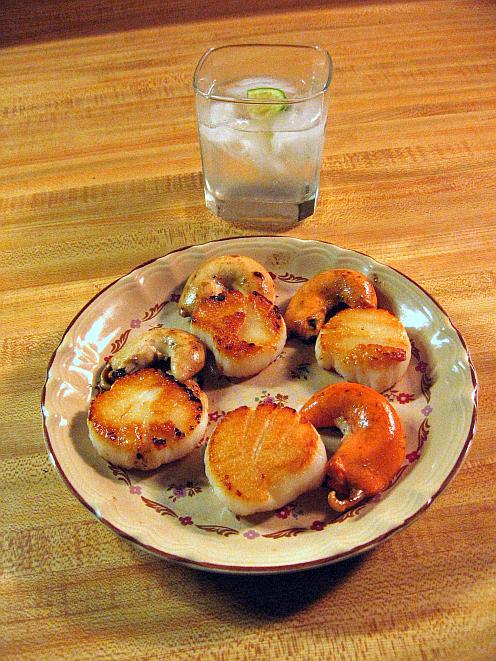
Pan seared with roe, and a cold gin & tonic.
Ideally you want them brown to dark brown on the ends and just barely cooked or raw in the middle. Don’t worry if you accidentally overcook them. Sea scallops are very forgiving and will still taste great even if overcooked a little. Yes, I know everyone says don’t overcook, but the truth is your scallops will taste fine even if you do overcook them.
Cook them them the same way on the grill. Just make sure your grill is well seasoned so the scallops don’t stick.
Another way to cook them is to sauté in butter. Use about a tablespoon of butter with a dash of olive oil to keep the butter from burning. Add the scallops and toss them about until they are just barely cooked.
Cooking the roe: Sea scallop roe takes about the same amount of time to cook as the scallops themselves. You can pan sear the roe, but I think it’s better to sauté in butter.
Conclusion
Sea scallops are easy to find on Long Island. Buy chemical free or buy off the boats if you can. They are delicious raw. Pan searing is the easiest and most popular way to cook them, and they will survive overcooking. Enjoy!
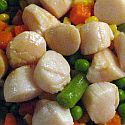
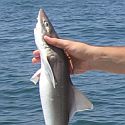
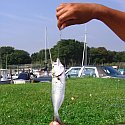
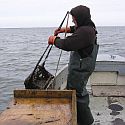





New! Comments
Have your say about what you just read! Leave me a comment in the box below.